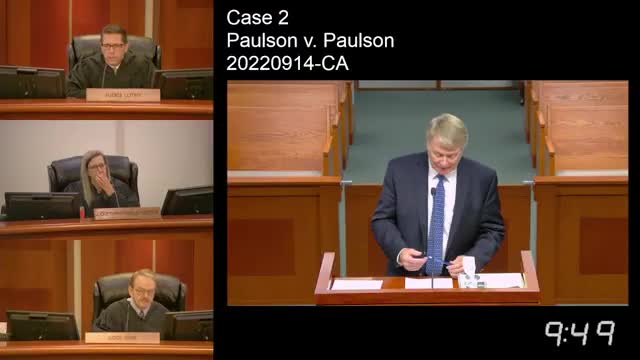Legal Team Discusses Expert Disclosure and Summary Judgment in Divorce Case
September 25, 2025 | Utah Court of Appeals Live Stream, Utah Appellate Court, Utah Judicial Branch, Utah
This article was created by AI summarizing key points discussed. AI makes mistakes, so for full details and context, please refer to the video of the full meeting. Please report any errors so we can fix them. Report an error »

In a recent session of the Utah Court of Appeals, the complexities of expert disclosure in legal proceedings took center stage, revealing the intricate balance between procedural rules and practical realities. As the discussion unfolded, the tension between the expectations set by Rule 26 and the actualities of litigation became apparent, particularly in the context of a high-stakes divorce case.
The meeting began with a focus on the adequacy of expert disclosures, a critical component in ensuring fair legal representation. One attorney highlighted a specific case where their team faced a tight two-week deadline to respond to an opposing party's expert report. This situation raised questions about the feasibility of complying with the rule's requirements when the necessary information was still being gathered. The attorney argued that while the rule mandates a summary of expected opinions, it does not account for the timing of when those opinions can be formed, especially when awaiting additional data.
As the dialogue progressed, the court grappled with the implications of these procedural challenges. The attorney pointed out that the language of the rule could be interpreted in various ways, leading to ambiguity that complicates compliance. This ambiguity was underscored by the fact that the opposing party had a full year to prepare their disclosures, while the attorney's team was left scrambling to meet a much shorter timeline.
The conversation then shifted to the concept of harm, a crucial element in determining the impact of any procedural missteps. The attorney contended that the alleged harm in this case was self-inflicted, stemming from strategic decisions made by the opposing party rather than any deficiencies in the disclosure process itself. The court acknowledged that harm must be assessed in relation to the ability to present a case effectively, rather than merely the costs incurred from filing motions.
Ultimately, the meeting illuminated the ongoing challenges faced by legal professionals in navigating the intersection of established rules and the unpredictable nature of litigation. As the court deliberated on these issues, it became clear that the resolution of such procedural dilemmas is essential not only for the parties involved but also for the integrity of the judicial process itself. The discussions from this meeting will likely resonate in future cases, as the court continues to refine its understanding of expert disclosures and their implications in the legal landscape.
The meeting began with a focus on the adequacy of expert disclosures, a critical component in ensuring fair legal representation. One attorney highlighted a specific case where their team faced a tight two-week deadline to respond to an opposing party's expert report. This situation raised questions about the feasibility of complying with the rule's requirements when the necessary information was still being gathered. The attorney argued that while the rule mandates a summary of expected opinions, it does not account for the timing of when those opinions can be formed, especially when awaiting additional data.
As the dialogue progressed, the court grappled with the implications of these procedural challenges. The attorney pointed out that the language of the rule could be interpreted in various ways, leading to ambiguity that complicates compliance. This ambiguity was underscored by the fact that the opposing party had a full year to prepare their disclosures, while the attorney's team was left scrambling to meet a much shorter timeline.
The conversation then shifted to the concept of harm, a crucial element in determining the impact of any procedural missteps. The attorney contended that the alleged harm in this case was self-inflicted, stemming from strategic decisions made by the opposing party rather than any deficiencies in the disclosure process itself. The court acknowledged that harm must be assessed in relation to the ability to present a case effectively, rather than merely the costs incurred from filing motions.
Ultimately, the meeting illuminated the ongoing challenges faced by legal professionals in navigating the intersection of established rules and the unpredictable nature of litigation. As the court deliberated on these issues, it became clear that the resolution of such procedural dilemmas is essential not only for the parties involved but also for the integrity of the judicial process itself. The discussions from this meeting will likely resonate in future cases, as the court continues to refine its understanding of expert disclosures and their implications in the legal landscape.
View full meeting
This article is based on a recent meeting—watch the full video and explore the complete transcript for deeper insights into the discussion.
View full meeting

